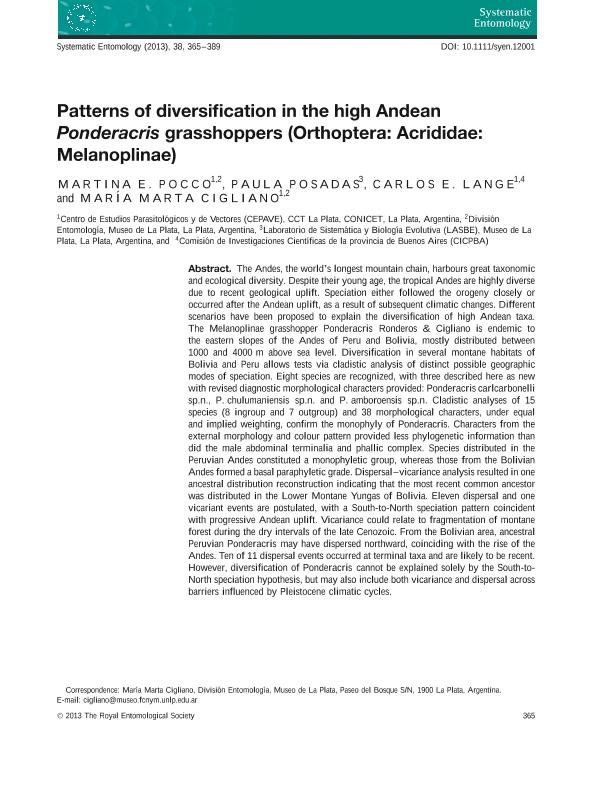Artículo
Patterns of diversification in the high Andean Ponderacris grasshoppers (Orthoptera: Acrididae: Melanoplinae)
Fecha de publicación:
11/2012
Editorial:
Wiley
Revista:
Systematic Entomology (print)
ISSN:
0307-6970
e-ISSN:
1365-3113
Idioma:
Inglés
Tipo de recurso:
Artículo publicado
Clasificación temática:
Resumen
The Andes, the world’s longest mountain chain, harbours great taxonomic and ecological diversity. Despite their young age, the tropical Andes are highly diverse due to recent geological uplift. Speciation either followed the orogeny closely or occurred after the Andean uplift, as a result of subsequent climatic changes. Different scenarios have been proposed to explain the diversification of high Andean taxa. The Melanoplinae grasshopper Ponderacris Ronderos & Cigliano is endemic to the eastern slopes of the Andes of Peru and Bolivia, mostly distributed between 1000 and 4000 m above sea level. Diversification in several montane habitats of Bolivia and Peru allows tests via cladistic analysis of distinct possible geographic modes of speciation. Eight species are recognized, with three described here as new with revised diagnostic morphological characters provided: Ponderacris carlcarbonelli sp.n., P. chulumaniensis sp.n. and P. amboroensis sp.n. Cladistic analyses of 15 species (8 ingroup and 7 outgroup) and 38 morphological characters, under equal and implied weighting, confirm the monophyly of Ponderacris. Characters from the external morphology and colour pattern provided less phylogenetic information than did the male abdominal terminalia and phallic complex. Species distributed in the Peruvian Andes constituted a monophyletic group, whereas those from the Bolivian Andes formed a basal paraphyletic grade. Dispersal–vicariance analysis resulted in one ancestral distribution reconstruction indicating that the most recent common ancestor was distributed in the Lower Montane Yungas of Bolivia. Eleven dispersal and one vicariant events are postulated, with a South-to-North speciation pattern coincident with progressive Andean uplift. Vicariance could relate to fragmentation of montane forest during the dry intervals of the late Cenozoic. From the Bolivian area, ancestral Peruvian Ponderacris may have dispersed northward, coinciding with the rise of the Andes. Ten of 11 dispersal events occurred at terminal taxa and are likely to be recent. However, diversification of Ponderacris cannot be explained solely by the South-toNorth speciation hypothesis, but may also include both vicariance and dispersal across barriers influenced by Pleistocene climatic cycles.
Palabras clave:
Melanoplinae
,
High Andes
,
Dispersal-Vicariance Analysis
,
Phylogeny
Archivos asociados
Licencia
Identificadores
Colecciones
Articulos(CEPAVE)
Articulos de CENTRO DE EST.PARASITOL.Y DE VECTORES (I)
Articulos de CENTRO DE EST.PARASITOL.Y DE VECTORES (I)
Citación
Pocco, Martina Eugenia; Posadas, Paula Elena; Lange, Carlos Ernesto; Cigliano, Maria Marta; Patterns of diversification in the high Andean Ponderacris grasshoppers (Orthoptera: Acrididae: Melanoplinae); Wiley; Systematic Entomology (print); 38; 2; 11-2012; 365–389
Compartir
Altmétricas




